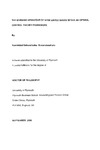Dividend behaviour of NYSE-listed banks within an optimal control theory framework
| dc.contributor.supervisor | Pointon, John | |
| dc.contributor.author | Mukonoweshuro, Rumbidzai Ushendibaba | |
| dc.contributor.other | Plymouth Business School | en_US |
| dc.date.accessioned | 2011-05-11T11:31:42Z | |
| dc.date.available | 2011-05-11T11:31:42Z | |
| dc.date.issued | 2008 | |
| dc.identifier | Not available | en_US |
| dc.identifier.uri | http://hdl.handle.net/10026.1/382 | |
| dc.description.abstract |
Within the dividend policy literature there is no universally accepted model to explain dividend behaviour. The theoretical dividend policy literature contains a promising dynamic mathematical model based on optimal control theory formulated by Davidson (1980), in the spirit of the Modigliani-Brumberg-Yaari types of lifecyle hypothesis, but despite being published some time ago the model has not been tested empirically, possibly due to its complexity. It is the main purpose of this research study to investigate the dividend behaviour patterns of banks listed on the NYSE within this optimal control theory framework. This work unfolds in three stages as follows: initially the impacts of the different control planning horizons in determining dividend patterns are examined. Secondly, the factors that govern the control-theoretic dividend patterns are established. Finally the factors that are associated with out-performers of the control theory framework are identified. Appropriate and relevant data from NYSE banking corporations were obtained to test the effectiveness and efficiency of the control theory framework. The application of logistic regression analysis and logistic step-wise regression established the factors that govern the control-theoretic dividend patterns. The application of multiple regression analysis and step-wise regression analysis enabled this study to determine the factors that are associated with out-performers of the control theory framework. Research findings suggest that the long planning horizon model tends to be good explanator of observed dividends, suggesting that the dividend decision is not constrained by short or medium term predicted liquid asset levels. NYSE banks with control-theoretic dividend patterns were associated with the smaller banks, which perform financially well and display a strong share price record, as indicated by the high Tobin's Q ratio, strong dividend yield, a greater return on capital invested, higher leverage, and a smaller number of employees. The NYSE banks with observed dividends that out-perform the control theory framework are associated with banks that have higher profits, as indicated by the higher return on equity, and an implied expanding customer base, as suggested by the higher revenue growth rate. Outperfoming banks also have higher dividend yields, constrained by an implied internally imposed conservative retention policy, as indicated by lower payout ratios and they tend to be smaller in size. Further research in this area is required to investigate the dividend behaviour of organisations operating on other stock markets around the world, and should help to unlock the full potential that is offered by a control theory framework. | en_US |
| dc.language.iso | en | en_US |
| dc.publisher | University of Plymouth | en_US |
| dc.title | Dividend behaviour of NYSE-listed banks within an optimal control theory framework | en_US |
| dc.type | Thesis | |
| dc.identifier.doi | http://dx.doi.org/10.24382/4372 | |
| dc.identifier.doi | http://dx.doi.org/10.24382/4372 |
Files in this item
This item appears in the following Collection(s)
-
01 Research Theses Main Collection
Research Theses Main


